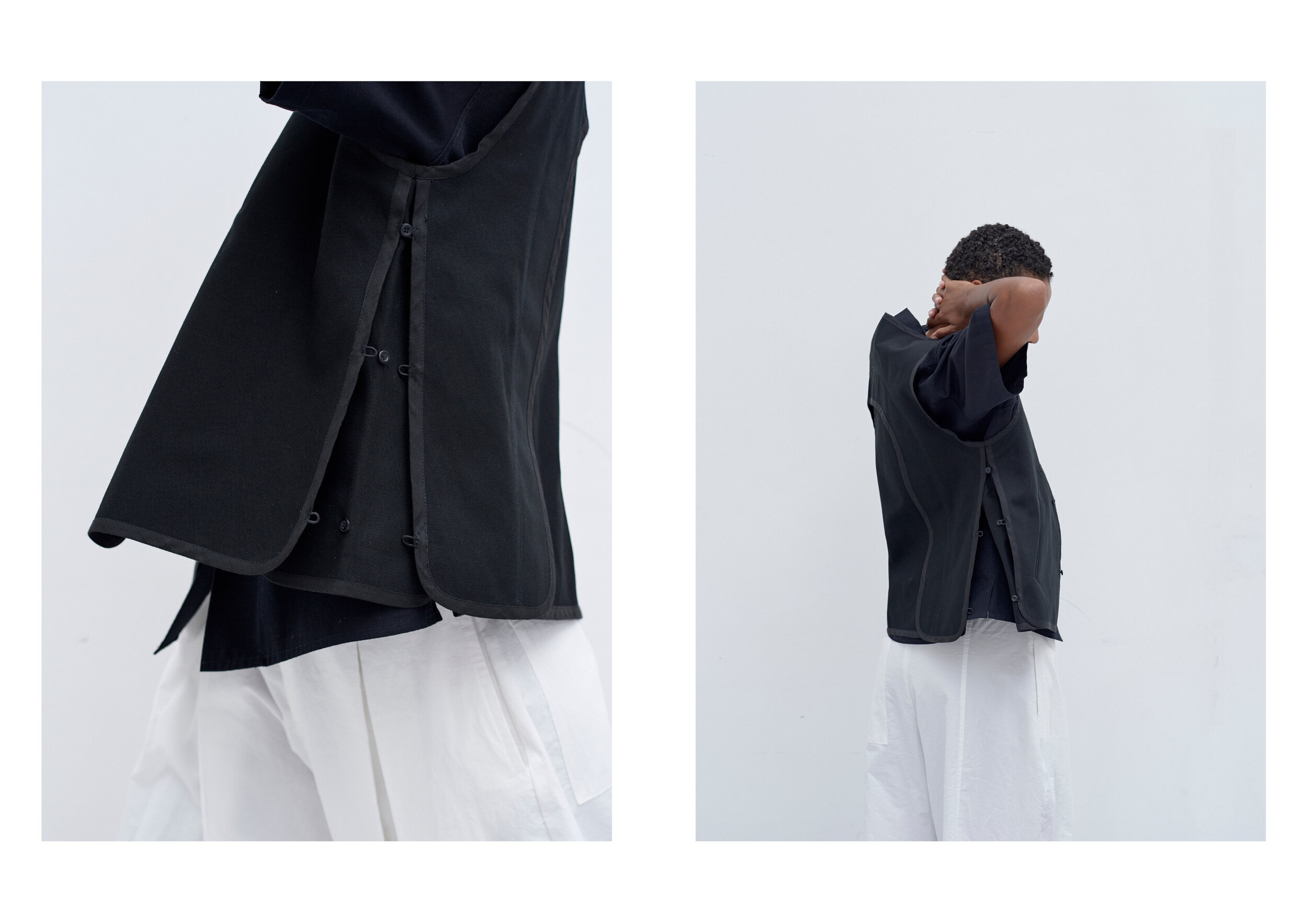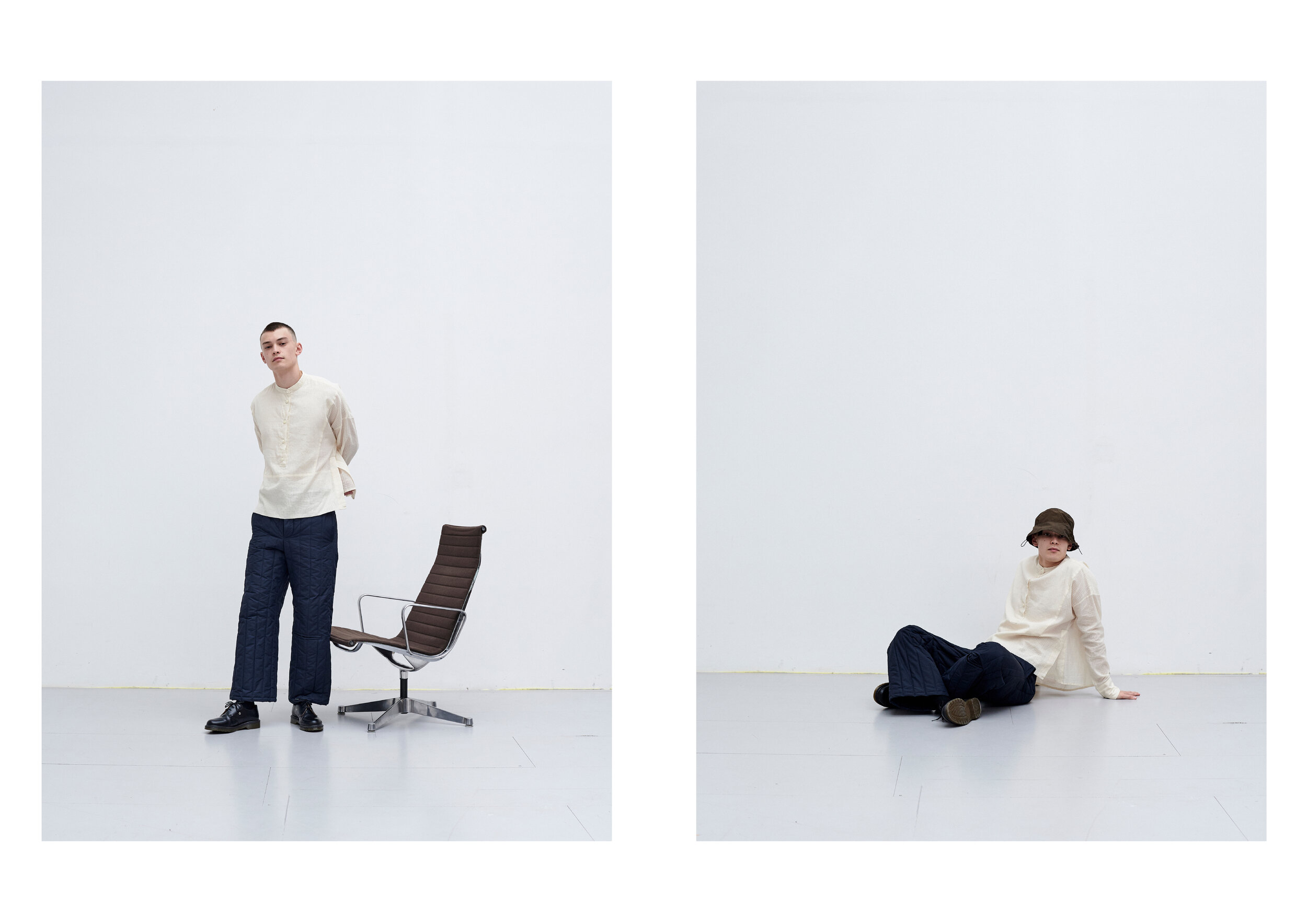SAGE NATION - BRIDGING CULTURES THROUGH DESIGN
Inspired by designer Sage Toda-Nation’s dual heritage, Sage Nation is an eponymous label which materializes two cultures by way of streamlined silhouettes, innovative design, and meaningful construction. For his debut collection, the up and coming designer translates Japanese and British culture through a detailed study of traditional combat uniforms; a tangible commonality which offers a harmonious and functional vision of his cultural duality. Paying close attention to the traditional materials and methods of design, each garment is designed in unison to create a modular wardrobe which addresses the nuances of daily life.
Striking a conceptual balance between style and practicality, his multifunctional pieces are carefully constructed to accommodate the uncertainties of contemporary life. These aims are manifested through both the Hybrid Detachable Jacket and oversized Poncho. The Hybrid Jacket incorporates a removable upper to serve as both a jacket and a utility vest, while the Poncho can be reimagined as an adjustable weatherproof skirt. Alongside these garments, Toda’s collection seamlessly expands on a series of legacy shapes and staples to deliver a collection of non-seasonal, adaptable, and genderless clothing for the current day. The collection will be available soon online and at select stockists. Continue below to view the complete lookbook shot by photographer Matt Marsh, and an exclusive interview between Sage and Alexa.
Besides its most technical purpose, what was photography's role in presenting your collection?
I feel that photography is very important to the DNA of the brand. It’s how we communicate the final product to the audience. Without this communication, the true beauty and intention of the garments may not come across as intended. It’s also an important tool for expressing the mood or feeling that we are trying to convey through the brand.
From a young age, I was aware of the importance of communication through photography because my mother was a photographer. My right hand man, Louis Flashman, also works in photography, so it is always at the forefront of our minds when working on the collection.
What immediately drew me to your lookbook was the composition and movements of the models. The juxtaposition of using traditional materials/methods of design and the sense of a "non-traditional" lookbook is visually striking. And, I think the movement of each shot really compliments your dynamic pieces. Could you speak more on your intention here?
I’m glad you picked up on this through the visuals. Something I am very conscious of when designing and moving forward with the brand, is that we focus on making ‘real’ clothes for ‘real’ people. A lot of the designs are made to transform and change to adapt to dynamic movement. I want my clothes to be comfortable and to enhance everyday life, not restrict it.
We also strive to strike a balance between the outdoors and the city. This hybrid lifestyle we are trying to promote is embodied by the range of dynamic movements we use during shoots, and has more recently manifested in a collaboration with the hiking brand Keens, who promote the same lifestyle. I am aware that we already have more than enough clothing in this world, so our clothes need to be able to be worn practically and encourage movement.
I also find beauty in the subtle juxtaposition of things. In life, I think the most beautiful things have an element of contrast to them. This is why I like using playful stances during shoots, which combined with movement, accentuate the very simple, refined clothes.
Your collection also noticeably disregards visual gender representations and really captures the naturality of timeless, functional, and genderless clothing. What initially inspired you to approach your lookbook/garments from this perspective?
When it came to this idea of the collection being, as we like to say, ‘genderless’, it is not meant as a political decision by any means. As a designer, I believe we should work towards making clothes as inclusive as possible. My favourite part of a garment is always the shoulder, which I feel is often what defines the garment as ‘menswear’ or ‘womenswear’. So I focus on finding the balance in the shoulder, which often leads to many of the pieces having a very relaxed, dropped shoulder that is more versatile. As well as this, a lot of the clothes can be adjusted to fit all sizes: such as the drawstring skirt and the poncho. I get enjoyment from clothes that are not restricted by silhouette, but instead enhanced by it.
What influenced the photographic vision of your lookbook? Things, places, people, culture? The last shot in your lookbook really brings to mind one of my favourite books "The Beauty of Everyday Things".
My friends and colleagues influence my work highly. My friend Jesse Crankson and I will spend hours talking about films that have influenced us over the years and even everything down to tv adverts. I also have a great relationship with Matt Marsh: the photographer that shot the lookbook. I use him for all my ecomm shoots. I think it is important to have a good relationship with whoever you are shooting with because it shows through the images. Maintaining continuity going forward is something that is also very important to us. I think to really develop a strong DNA as a brand, you have to keep working with the same people time and time again to build a good foundation for genuine growth.
For some of the shots and compositions, I often draw a lot of inspiration from my all time favourite film director Takeshi Kitano. I love the use of empty space in his movies and the general atmosphere he manages to create through visuals. There’s so much beauty to be found in imagery that utilizes space to a create calm visuals. We also like to experiment a lot with expired film and medium format film, some of which we will be releasing after the lookbook fully released. I find working with multiple mediums is essential for adding another layer to the brand and to create a real mood behind what we are trying to do.
We carefully chose all the props in the shoot. For example the Eames chair we used, is a chair of great sentimental value to Louis. Everything we do has to have a reason or a purpose. I think it is important to have that depth to even a very simple image.






























